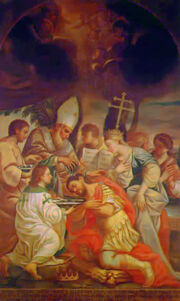The Armenian Apostolic Church (Armenian: Հայ Արաքելական Եկեղեցի), sometimes called the Armenian Orthodox Church is the world's oldest national church and one of the most ancient Christian communities.
Origins and history[]

Baptism of Tiridates III.
The earliest accounts of the introduction of Christianity into Armenia date from the 1st century, when it was first preached by two Apostles of Jesus, St. Bartholomew and St. Thaddeus. The Armenian Apostolic Church has been around since the days of the apostles and therefore has a rightful claim as one of the oldest denominations in Christianity. Armenia was the first country to adopt Christianity as its official religion, in 301, when St. Gregory the Illuminator converted Tiridates III (the King of Armenia) and members of his court.
<templatestyles src="Hlist/styles.css"></templatestyles><templatestyles src="Plainlist/styles.css"></templatestyles><templatestyles src="Module:Sidebar/styles.css"></templatestyles>
| Part of a series on |
| Eastern Christianity |
|---|
 |
| Christianity portal |
Christianity was strengthened in Armenia by the translation of the Bible into the Armenian language by the Armenian theologian, monk and scholar Saint Mesrop Mashtots.
Monophysite label[]
Historically, the Armenian church has been labeled monophysite because it (just as the Coptic Orthodox Church and other branches of Oriental Orthodoxy) rejected the decisions of the Council of Chalcedon, which condemned monophysitism. The Armenian Church officially severed ties with the West in 554, during the second Council of Dvin where the dyophysite formula of the Council of Chalcedon was rejected.
However, the Armenian Orthodox Church argue that this is a wrong description of its position, as it considers Monophysitism, as taught by Eutyches and condemned at Chalcedon, a heresy and only disagrees with the formula defined by that council. The Armenian church instead adheres to the doctrine defened by Cyril of Alexandria, considered by Saint Chalcedonian churches as well and described Christ as being of one nature of Christ, where both divine and human nature are united. To distinguish this from Eutychian and other versions of Monophysitism this position is called miaphysitism.
In recent times, both Chalcedonian and anti-Chalcedonian churches have developed a deeper understanding for each other's positions, recognizing the substantial agreement while maintaining their respective theological language. Hence, the Monophysite label is avoided to describe the Armenians' or Copts' belief regarding the Nature of Christ.
Structure and leadership[]
The Armenian Apostolic Church is headed by a Catholicos (the plural is Catholicoi). (The Armenian Apostolic Church should not be confused, however, with the Armenian Catholic Church, which is an Eastern Rite Catholic church under the authority of the Pope in Rome.) At present, the Catholicos of All Armenians is his Holiness Karekin II (sometimes spelled as Garegin), who resides in the city of Echmiadzin, west of Yerevan. A second Catholicos, His Holiness Aram I Catholicos of Cilicia, who resides in Antilyas in Lebanon, leads churches belonging to the Holy See of Cilicia. The division stems from frequent relocations of the Church headquarters under Ottoman Rule and was further reinforced during the period in which Armenia was part of the Soviet Union. However, the Catholicos of All Armenians claims theoretical sovereignty over the Catholicos of Cilicia.
Similarities to other churches[]
Liturgically, the Church has much more in common with the Latin rite, especially as it was at the time of separation, than other Orthodox rites. For example, their bishops wear vestments almost identical to those of Western bishops. They usually do not use a full iconostasis, but rather a curtain (which was also used in the West at the time of separation). The liturgical music is Armenian chant.
Armenian priests of the lower ranks are allowed to marry.
Today[]
Today there are large Armenian Apostolic congregations in many countries outside Armenia, including the United States, France, Russia, Lebanon, Syria, Canada, and others. Of particular importance is the Armenian Apostolic Church of Iran (see also Christians in Iran) where Armenians are the largest Christian ethnic minority.
External links[]
- The Armenian Church
- Diocese of the Armenian Church of America (Eastern)
- Armeniapedia - Armenian Apostolic Church
- Armenian Apostolic (Orthodox) Church Library Online (in English)
- Armenian Apostolic (Orthodox) Church Library Online (in Armenian)
- Armenian Apostolic (Orthodox) Church Library Online (in Russian)
- Directory of Armenian Churches Worldwide
- Prayer Book of the Armenian Church
- The Diocese of the Armenian Church of America (Western)
- Armenian Patriarchate of Jerusalem
- The Araratian Diocese of the Armenian Apostolic Church
- Example usage of Gregorian Church
- Embassy of the Republic of Armenia to the US General Information
See also[]
| This page uses Creative Commons Licensed content from Wikipedia (view authors). |